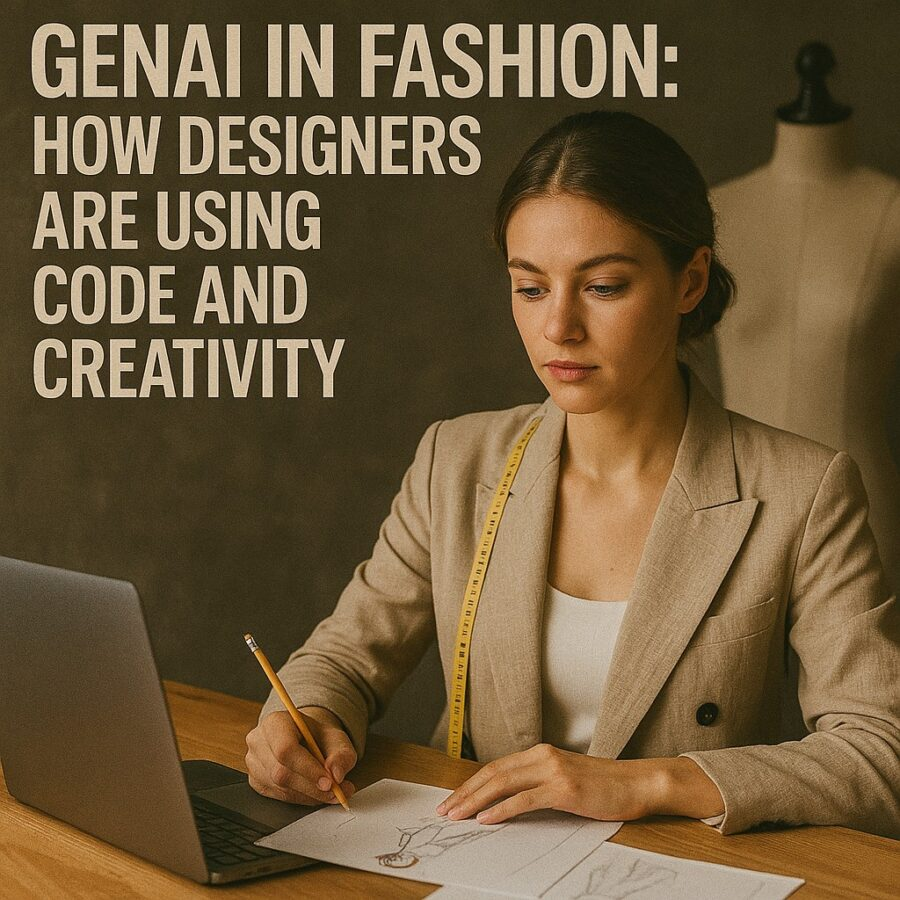Views: 2
Fashion has always been a dialogue between art and technology. From the sewing machine to digital design software, each new tool has reshaped how clothing is imagined and produced. The arrival of generative artificial intelligence represents the next evolution. GenAI in fashion is not a distant concept. It is already influencing design studios, retail platforms, and runway shows.
This article explores how designers are blending code with creativity, the opportunities and challenges ahead, and what this transformation means for the future of style.
Why GenAI in Fashion Matters
The global fashion industry thrives on speed and innovation. Consumers demand constant novelty, while brands face pressure to reduce costs and environmental impact. Generative AI offers solutions on both fronts.
By harnessing algorithms capable of producing original patterns, textures, and even entire collections, designers can accelerate workflows and expand their creative palettes. GenAI in fashion promises not only efficiency but also entirely new forms of aesthetic expression.
From Sketches to Systems
Traditionally, fashion design begins with sketches. These hand-drawn ideas translate into prototypes, which evolve through multiple iterations. Generative AI compresses this process. By training on vast datasets of historical styles, fabrics, and cultural references, AI systems can propose dozens of variations instantly.
Designers now guide models through prompts or code, curating results rather than laboring through every iteration manually. This shift illustrates how GenAI in fashion transforms the role of the creator. The designer becomes both artist and conductor, orchestrating algorithms as creative collaborators.
Case Studies of GenAI in Fashion
Several early applications show the range of possibilities.
- Textile patterns: AI generates intricate prints inspired by cultural motifs, geometric structures, or natural elements. These patterns move directly into production.
- Virtual try-ons: Retailers use generative models to create realistic images of customers wearing garments, reducing the need for physical samples.
- Runway concepts: Avant-garde designers experiment with AI to visualize outfits that defy physics, inspiring future collections.
- Sustainable design: Brands explore fabric efficiency by using AI to calculate how patterns fit together, minimizing waste.
Each case highlights the potential of GenAI in fashion to enhance creativity while solving practical industry challenges.
Blending Code and Creativity
Designers do not need to be software engineers, but understanding code helps unlock AI’s potential. Some fashion professionals learn programming basics to fine-tune outputs. Others collaborate with technologists who translate creative visions into computational instructions.
This interdisciplinary approach ensures that technology does not overshadow artistry. The marriage of code and creativity defines how GenAI in fashion evolves. It is less about replacing human designers and more about expanding their expressive reach.
The Democratization of Fashion Design
Generative AI lowers barriers to entry. Tools once available only to major fashion houses are becoming accessible to independent creators and even hobbyists. With platforms that accept text prompts and images, anyone can experiment with styles, palettes, and silhouettes.
This democratization raises new possibilities. Local designers can compete on global stages, and consumers may co-create custom garments. The spread of GenAI in fashion mirrors earlier shifts in music and publishing, where digital tools empowered creators outside traditional gatekeepers.
The Ethical Questions
With opportunity comes responsibility. Generative AI in fashion raises several ethical concerns.
- Intellectual property: Models trained on existing collections may replicate elements of copyrighted designs without permission.
- Cultural appropriation: Algorithms drawing on global data may unintentionally produce insensitive or exploitative patterns.
- Labor impact: Automation of design tasks could reduce demand for certain creative roles, disrupting careers.
These issues remind us that GenAI in fashion must be pursued with care. Codes of conduct, transparency in data sourcing, and collaboration with diverse communities are essential safeguards.
Sustainability and Environmental Impact
The fashion industry is notorious for waste and overproduction. Generative AI offers tools to address these issues. By simulating designs digitally, companies can reduce the number of physical samples produced. AI-driven supply chains also predict demand more accurately, minimizing unsold inventory.
Sustainable design is not just a trend but a necessity. The ability of GenAI in fashion to optimize resources may play a crucial role in aligning creativity with environmental responsibility.
Consumer Engagement and Personalization
Generative AI allows brands to personalize fashion at scale. Customers can input preferences, and AI systems generate tailored recommendations or even custom clothing designs. This creates stronger connections between consumers and brands while reducing the sense of mass production.
Interactive experiences, such as virtual dressing rooms or co-design platforms, further expand engagement. These tools illustrate how GenAI in fashion is not confined to the design studio. It also reshapes how people shop, wear, and relate to clothing.
The Role of Education and Training
Fashion schools now face the challenge of incorporating AI literacy into their curricula. Future designers must be comfortable blending traditional skills with digital tools. Courses on computational creativity, ethics, and sustainable AI are becoming as relevant as fabric studies and draping techniques.
By preparing students for the age of GenAI in fashion, educational institutions ensure that the next generation of creators is equipped to lead rather than follow technological change.
Global Perspectives on GenAI in Fashion
Different regions approach the integration of AI in unique ways.
- Europe: Emphasis on sustainability aligns with using AI for eco-conscious design.
- United States: Tech-forward fashion houses experiment with AI as part of brand storytelling.
- Asia: Rapid adoption in e-commerce and social media integrates generative AI into consumer culture at scale.
These global differences show that GenAI in fashion is not a uniform trend but one shaped by cultural values, markets, and regulatory environments.
What Companies Often Miss
While enthusiasm is high, organizations sometimes overlook critical aspects.
- Overreliance on novelty: Chasing flashy AI-generated concepts without grounding them in wearability risks alienating consumers.
- Lack of transparency: Not disclosing when AI is involved can erode trust.
- Ignoring inclusivity: Failing to test outputs across diverse body types and cultural backgrounds limits accessibility.
These gaps highlight why responsible integration of GenAI in fashion requires more than enthusiasm. It demands a deliberate strategy rooted in ethics, inclusivity, and long-term value.
The Future of Runways and Retail
Looking ahead, the fashion experience may change dramatically. Virtual runways could showcase collections entirely generated by AI, accessible globally without physical shows. Augmented reality may allow shoppers to see AI-generated variations of garments before purchase.
Retailers may shift from producing large seasonal inventories to offering generative platforms where customers order custom designs made on demand. These possibilities underscore the transformative potential of GenAI in fashion across the entire supply chain.
Balancing Art and Technology
One risk of generative AI is that it may prioritize efficiency over originality. If designers rely too heavily on algorithms, fashion risks becoming homogenized. Human creativity must remain central.
The most successful applications of GenAI in fashion will balance machine capability with human imagination. Algorithms can inspire and assist, but the soul of fashion lies in storytelling, culture, and individuality. Machines cannot replace that.
Closing Thoughts
Generative AI is redefining industries, and fashion is no exception. Designers are discovering how to use code as a creative tool, expanding possibilities while confronting ethical and practical challenges. GenAI in fashion represents both an opportunity and a responsibility.
The path forward will require balancing creativity with sustainability, innovation with inclusivity, and technology with artistry. If navigated wisely, generative AI could usher in a new golden age of design, where fashion becomes more personal, sustainable, and imaginative than ever before.
The question is not whether AI belongs in fashion but how it will shape the future of style. The road ahead depends on choices made by designers, companies, and consumers alike.





